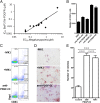An image-based screen identifies a small molecule regulator of megakaryopoiesis
- PMID: 22891346
- PMCID: PMC3435220
- DOI: 10.1073/pnas.1212545109
An image-based screen identifies a small molecule regulator of megakaryopoiesis
Abstract
Molecules that control the lineage commitment of hematopoietic stem cells (HSCs) may allow the expansion of enriched progenitor populations for both research and therapeutic uses. In an effort to better understand and control the differentiation of HSCs to megakaryocytes, we carried out an image-based screen of a library of 50,000 heterocycles using primary human CD34(+) cells. A class of naphthyridinone derivatives was identified that induces the differentiation of common myeloid progenitors (CMP) to megakaryocytes. Kinase profiling and subsequent functional assays revealed that these compounds act through inhibition of platelet-derived growth factor receptor (PDGFR) signaling in CMPs. Such molecules may ultimately have clinical utility in the treatment of thrombocytopenia.
Conflict of interest statement
The authors declare no conflict of interest.
Figures



References
-
- Kondo M, et al. Biology of hematopoietic stem cells and progenitors: Implications for clinical application. Annu Rev Immunol. 2003;21:759–806. - PubMed
-
- Lyssiotis CA, et al. Chemical control of stem cell fate and developmental potential. Angew Chem Int Ed Engl. 2011;50:200–242. - PubMed
-
- Peled T, et al. Pre-clinical development of cord blood-derived progenitor cell graft expanded ex vivo with cytokines and the polyamine copper chelator tetraethylenepentamine. Cytotherapy. 2004;6:344–355. - PubMed
-
- Eapen M, et al. Outcomes of transplantation of unrelated donor umbilical cord blood and bone marrow in children with acute leukaemia: A comparison study. Lancet. 2007;369:1947–1954. - PubMed
Publication types
MeSH terms
Substances
LinkOut - more resources
Full Text Sources
Other Literature Sources
Medical
Miscellaneous

